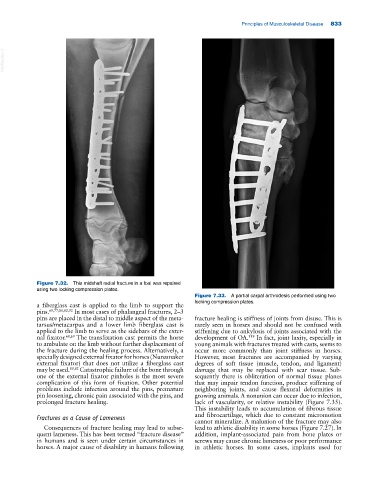Page 867 - Adams and Stashak's Lameness in Horses, 7th Edition
P. 867
Principles of Musculoskeletal Disease 833
VetBooks.ir
Figure 7.32. This midshaft radial fracture in a foal was repaired
using two locking compression plates.
Figure 7.33. A partial carpal arthrodesis performed using two
locking compression plates.
a fiberglass cast is applied to the limb to support the
pins. 69,77,80,82,92 In most cases of phalangeal fractures, 2–3
pins are placed in the distal to middle aspect of the meta fracture healing is stiffness of joints from disuse. This is
tarsus/metacarpus and a lower limb fiberglass cast is rarely seen in horses and should not be confused with
applied to the limb to serve as the sidebars of the exter stiffening due to ankylosis of joints associated with the
nal fixator. 68,69 The transfixation cast permits the horse development of OA. In fact, joint laxity, especially in
119
to ambulate on the limb without further displacement of young animals with fractures treated with casts, seems to
the fracture during the healing process. Alternatively, a occur more commonly than joint stiffness in horses.
specially designed external fixator for horses (Nunamaker However, most fractures are accompanied by varying
external fixator) that does not utilize a fiberglass cast degrees of soft tissue (muscle, tendon, and ligament)
may be used. 80,82 Catastrophic failure of the bone through damage that may be replaced with scar tissue. Sub
one of the external fixator pinholes is the most severe sequently there is obliteration of normal tissue planes
complication of this form of fixation. Other potential that may impair tendon function, produce stiffening of
problems include infection around the pins, premature neighboring joints, and cause flexural deformities in
pin loosening, chronic pain associated with the pins, and growing animals. A nonunion can occur due to infection,
prolonged fracture healing. lack of vascularity, or relative instability (Figure 7.35).
This instability leads to accumulation of fibrous tissue
Fractures as a Cause of Lameness and fibrocartilage, which due to constant micromotion
cannot mineralize. A malunion of the fracture may also
Consequences of fracture healing may lead to subse lead to athletic disability in some horses (Figure 7.27). In
quent lameness. This has been termed “fracture disease” addition, implant‐associated pain from bone plates or
in humans and is seen under certain circumstances in screws may cause chronic lameness or poor performance
horses. A major cause of disability in humans following in athletic horses. In some cases, implants used for

